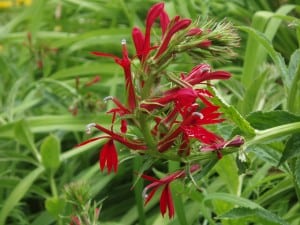By Pamela Doan
Now that the glacial mounds of snow have melted and I can see the ground again in most of the yard, I’m daydreaming about new landscaping projects. Moving a plant here, adding some color over there, and wouldn’t it look amazing to have a new flowerbed as the view through the office window? It would be lovely to add new landscaping on the path in the woods as well. There’s about a dozen plants that I picked up at end-of-season nursery sales to accommodate, too.

Chances are that when fall comes, only bits and pieces of these projects will be complete unless I whittle down the list into something more realistic. I’ve decided to rein in my impulse buying at plant sales — I mean, with 10 acres, I can always find a place for something, right? — and focus instead on cultivating areas with high impact plants that provide both aesthetic appeal and ecosystem benefits.
Native plants are my starting point because they are generally more suited to the climate and can be the least fussy in terms of maintenance and care. That’s definitely a guideline for my approach — low maintenance. I want plants that take care of themselves without a lot of watering, pruning/trimming or heavy feeding. Landscape designs and gardening practices that minimize weeding and other care requirements are important to me, too.
Here are a few of the selections I recommend, everything listed here is categorized as deer-resistant, too, which only means there is less of a chance of it being eaten, not that it’s actually safe. It all depends on the area.
Sunny spots with decent soil and average drainage
Liatris spicata or dense blazing star — this drought-tolerant perennial attracts hummingbirds, butterflies, and birds. It will get to be 3 to 4 feet tall and shoot up stalks with feathery, purple flowers among grassy leaves. It’s in the aster family of plants, which includes sunflowers. This plant can tolerate some shade, too. It will bloom in mid-summer.
Asclepias tuberosa or butterfly weed, also known as pleurisy root because its roots were chewed as relief for lung ailments — this milkweed perennial is easy to grow from seed and butterfly larva will feed on its leaves while adult butterflies will love its nectar. It stands 1 to 2 ½ feet tall and has brilliant orange flowers. It will self-seed once it’s established and I’d love to have a cluster that’s several feet in area. Butterfly weed has a nice, long bloom time in the summer.
Lonicera sempervirens or trumpet honeysuckle vine — this native vine is a better alternative to Japanese honeysuckle, which aggressively spreads. Although it isn’t fragrant, it has lovely clusters of trumpet-shaped blooms that are coral outside and yellow inside from late spring through summer followed by red berries that birds love. It can be a climber or a ground cover. Plant it and wait for the hummingbirds to show up.
Lobelia cardinalis or cardinal flower — this perennial has showy, scarlet, multi-lobed flowers that cascade gracefully from stalks. Ranging from 3 to 6 feet in height, it has serious impact in the landscape. While it prefers sun, it’s listed for shady spots, too. Hummingbirds will flock to it. I can’t confirm that this plant is deer-resistant, though, ask before purchasing it if that’s a concern.
Shade and part-shade plants
Tiarella cordifolia or Foamflower — this variety is a clumping plant; another variety is a spreading groundcover. Semi-glossy heart-shaped leaves frame a stalk that rises with white and pink flowers. I’ve had this in a shady flowerbed for two years and it sends out runners to spread so give it space in the beginning. The leaves will turn burgundy in the fall. Can grow to 12 to 18 inches high.
Solidago caesia or blue-stem goldenrod — this perennial has clusters of bright yellow flowers that really pop in a shady spot. It has a purplish stem and grows 1 to 3 feet high.
Jeffersonia diphylla or twinleaf — will complement the foamflower with dark green leaves and white flowers. Each plant only has a single bloom, but it has a longer life than a similar plant, bloodroot. The flowers have eight petals and later it bears fruit. This is an early bloomer in March-April and May.
Wildflower.org, the website for the Lady Bird Johnson Wildflower Center, has a comprehensive database for native plants.
Photo courtesy Lady Bird Johnson Wildflower Center
